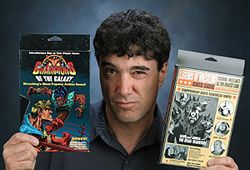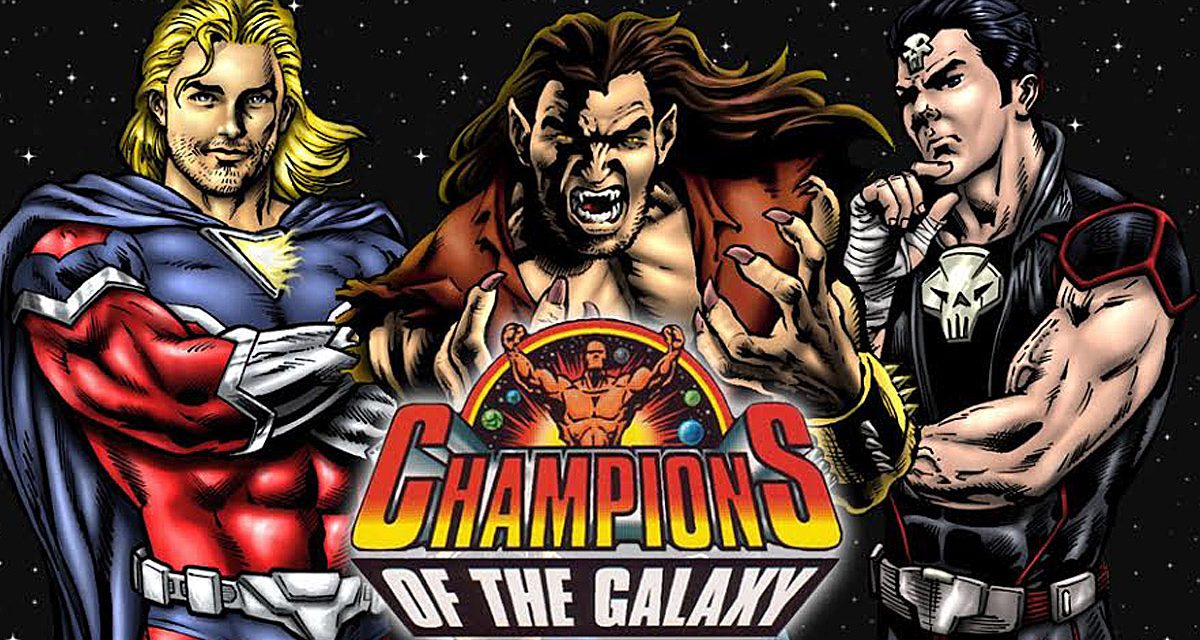It was because of this column that I received a copy of a book called The Dark Menace of the Universe. While there’s any number of Triple H jokes that could go here, the titular Dark Menace in this case is Tom Filsinger, a psychology professor at Jamestown Community College in Jamestown, New York. He’s also a game designer, the creative force behind Champions of the Galaxy — a card game featuring a futuristic wrestling federation with a sci-fi twist — and the more recent Legends of Wrestling.

Tom Filsinger
SLAM! Wrestling has reviewed some of Filsinger’s games before (see below), and the book’s look into the creation of those games might be enough to interest some readers. The author’s unsuccessful attempt to market an early version of his wrestling card game to the WWF is a story in and of itself, and even loyal COTG fans might not realize that a chance viewing of He-Man and the Masters of the Universe served as a spark of inspiration. And the encounters that led Filsinger to get Legends of Wrestling off the ground should be entertaining to anyone who appreciates wrestling history.
But The Dark Menace of the Universe is much more than just a look into game design. It’s so much more, in fact, that it’s hard to categorize. Take one part memoir, one part entrepreneurial handbook and one part theoretical essay on creativity, stir them all together and Dark Menace is the result. It sounds unwieldy, and it might not work except that all of the various elements are tied together (as the author himself notes in the very first chapter) by recurring themes. One of these themes is the concept of the “Dark Menace,” the creative person who sometimes clashes with society because of his or her propensity for thinking outside the box and unwillingness to play by the rules. Another of these themes, of course, is pro wrestling.
It turns out that wrestling has been an influence in Filsinger’s life since childhood, and his book has an early chapter devoted to his discovery of the mat game as a child and how he used it to bond with his grandparents. Like many fans, he went through a period of time when he drifted away, but not before booking his own fantasy matches in his parents’ basement with other neighborhood children in the mid-’70s. Filsinger found a way early on for wrestling to help serve as a creative outlet, an outlet he would revisit with his games decades later.
With a lifetime as a fan, 20-plus years as a fantasy booker and a book that has a bunch of chapters revolving around the mat game, it stands to reason that Filsinger would have some opinions on the state of the industry today, right?
“The wrestling business is in a creative slump,” said Filsinger recently, echoing the thoughts of many fans. “There are plenty of good performers, good workers, but not enough depth in terms of characterization or storylines. The industry has painted itself into a corner. Back 20 years ago there were still a lot of fans who thought wrestling was real and the result there was automatic heat. The performance was secondary to outcome… you REALLY wanted Jimmy Snuka to beat the crap out of Roddy Piper!
“Things are different now,” he continued. “It’s all about entertainment value since nearly 100% of wrestling fans know it’s a performance. That means the performance is held up to the standards we use when we judge movies and television shows. Everybody’s a critic.”
With that in mind, Filsinger said he wasn’t surprised that the ’90s saw a turn to more sex and violence, as well as an in-ring style that featured more high spots. The need to up the ante was obvious.
“But how far can you take that?” he asked rhetorically. “I don’t believe that the WWE or NWA-TNA have any long-term answers. They just keep trying things, sometimes pure shock value, hoping something will grab the attention of the casual wrestling fan, who they’ve lost. But nothing has worked.”
Somewhere in the middle of The Dark Menace of the Universe is an idea that might help. While modern wrestling feuds are usually personal affairs, man versus man or woman versus woman, with the occasional tag team scuffle, Champions of the Galaxy has mostly revolved around team feuds. In his book, Filsinger writes that finding the drama and endless possibilities inherent in the team concept is one of his proudest accomplishments.
Filsinger pushes these ideas because they’ve worked for him. The real life feds caught on for a bit; think nWo or D-Generation X. Dark Menace even tells the story of how former COTG artist (and now superstar comic book writer) Brian Bendis thought that the WWF and others were possibly borrowing ideas from the game’s storylines. But the team idea is nearly extinct today, and Filsinger thinks there is a lot of potential still waiting to be tapped.
“The major feds have never committed themselves to the team concept,” he said. “For example, the nWo was a huge success, but once it ran its course the WCW was dead. What they should have done was formed a counterteam to the nWo. They should have had some huge feuds with the nWo going against the Four Horsemen or some other teams.
“The Evolution concept was wasted in the same way. Somebody like Randy Orton should have formed a counterteam when he was kicked out of Evolution. Isn’t that the most obvious thing in the world that if your enemies are part of a team that you should form a team to fight them? Didn’t we all get tired of watching Evolution gang up on some wrestler, and didn’t we all wonder why the guy didn’t have any allies doing the same thing for him?”
Much like professional sports, the idea is that players or wrestlers may come and go, but interest in the team remains. Betrayals and turns have a lot more impact because they affect more people. And the chances for fans to care about performers further down the card increase dramatically.
“Individual wrestlers who would normally be midcarders suddenly become important when they are part of a team structure,” Filsinger said. “The storyline possibilities become endless. I’ve used a team-centered approach in writing Champions of the Galaxy for over 20 years and it’s one of the reasons for the success and longevity of the GWF. And here we are, the little guy, without big money or TV deals to promote us, yet still we have loyal fans.”
Filsinger makes it sound easy, but if all it took was one good idea to keep a game going for decades, or a wrestling fed for that matter, everyone would be doing it. Any from of entertainment that catches on has compelling characters, and the Dark Menace has been creating them for years. New updates for COTG come out every six months, and though it seemed like the GWF might be wrapping up a few years ago in a series called The End, it was, appropriately enough, part of a storyline.
Forging new stars on paper is easier than dealing with real, flesh-and-blood people. Filsinger appreciates that fact but still has a test to pass every time he sets a new batch of wrestlers loose in his game’s world.
“I’ve got it easy,” Filsinger said. “I don’t have to deal with wrestler egos, drug problems, steroids or people who don’t get along with each other. That being said, it’s still a challenge to create wrestlers who will capture the imagination of the fans. I got lucky in the first edition of Champions of the Galaxy with popular and enduring characters like Star Warrior, Wolf and Thantos, to say nothing of the Gladiators. But it’s hard to keep creating new stars without repeating yourself.”
So how does the booker or the game designer come up with new ideas? How does a creative person in any field, for that matter, deal with the pressures and uncertainties of the creative process? Those are good questions, and some answers are also found in The Dark Menace of the Universe. They’re also good reasons to come back in seven days for Part II of this column.
And if you can’t wait that long, you can always check out the book for yourself.
RELATED LINKS
- Mar. 6, 2006: Thoughts from the Dark Menace, Part II
- Champions of the Galaxy website
- SlamWrestling’s Champions of the Galaxy story archive

